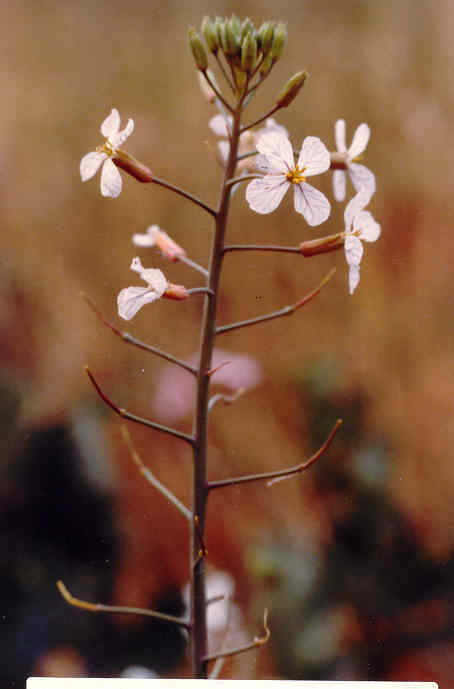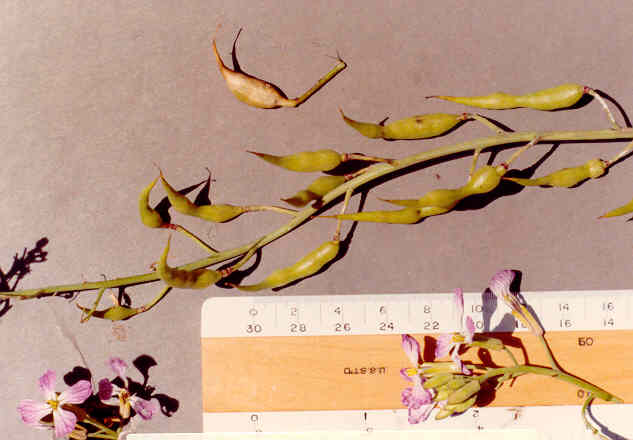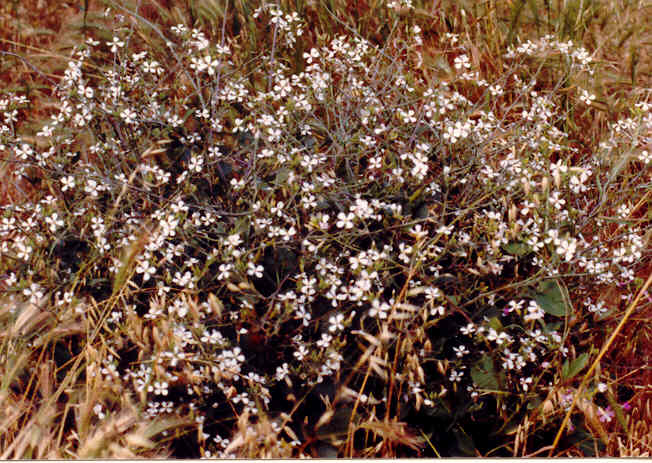
 |
Raphanus sativus L.Brassicaceae
(Mustard Family)
Europe
Wild Radish |
Plant Characteristics:
Annual or biennial, erect, branched, 3-12 dm. tall, subglabrous to
scattered-hispid; lower leaves pinnately parted, 1-2 dm. long with large rounded
terminal segment; upper leaves toothed; pedicels ascending 1-2 cm. long; sepals
narrow about 9-10 mm.; petals 15-20 mm. long, white, lavender, pink, generally
dark veined; fr. 4-7.5 cm. long including the conical beak, 2-3 seeded and 6-8
mm. thick, not or +/- narrowed, not breaking between seeds, upper part widest
below middle, not to +/- grooved.
Habitat:
Waste places, fields, etc. through much of Calif., below 1000 m.
Feb.-July.
Name:
Greek, raphanos, quick
appearing, because of rapid germination of seeds.
(Munz, Flora So. Calif. 297).
Latin, sativus, that which is
sown. (Jaeger 228). Species name probably refers to the fact that the plant has
been cultivated.
General:
Very common throughout the study area.
Photographed on the North Star Flats.
(my comments). The garden radish is a cultivated form.
The radish originated in China; was cultivated by the Pharaohs in Egypt.
In some countries the leaves and pods are eaten rather than the root.
The leaves may be eaten in the same manner as black mustard.
The root of the wild radish is often too woody to use in traditional
ways. The flowers may be used in salads or eaten alone.
(Clarke 210-211). Some
years R. sativus is very prevalent and
causes serious crop losses, especially in grain fields of the Central Valley.
The yields of grain in some areas have been reduced more than 50% due to
radish. It is especially serious in
flax. (Robbins et al. 233).
The green seeds of nearly ripe pods are tasty.
(John Johnson).
R. sativus has been found to
accumulate free nitrates in quantities capable of causing death or discomfort to
cattle. (Fuller).
Delfina Cuero, a southern Diegueno or Kumeyaay Indian made the following
comment about Raphanus sp. in her autobiography: "We cooked the young leaves
and stems for greens. For medicine,
we grind the seeds, boil and strain to use the liquid to bathe inflamed eyes,
and for pink eyes." (Shipek
95). About
4 species of Eurasia. (Munz, Flora
So. Calif. 297).
Text Ref:
Hickman, Ed. 434; Munz, Calif. Flora 238; Munz, Flora
So. Calif. 297; Roberts 16.
Photo Ref:
April 3 83 # 15; April-May 84 # 10.
Identity: by R. De Ruff, confirmed by B. Hailey.
First Found: April 1983..
Computer Ref:
Plant Data 13.
Have plant specimen.
Last edit 6/8/05.
 |
 |
May Photo April Photo